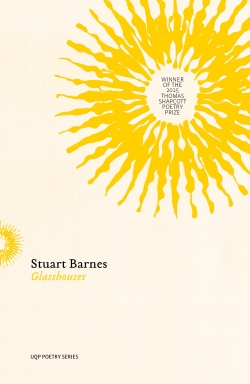Glasshouses
by Stuart Barnes
reviewed by Timothy Ogene
At the beginning of Geoges Perec’s An Attempt at Exhausting a Place in Paris, the narrator shares his modest goal: to capture “what happens when nothing happens other than the weather, people, cars, and clouds.” So, for three days, shifting between two angles, he draws up lists of objects that are “generally not taken note of … ” that are not in themselves important. His process is unusual but intriguing. In the end, his cluster of lists grows into a harmonious—if not eccentric—addition to the reader’s imagined experience of “things in place Saint-Sulpice.”
But the question is, how well can we narrate experience by merely naming its parts, by merely drawing up a list of hints and signs? And how can a poem realize that goal without explicitly drawing attention to each part as indicative of a presumed whole? The poems in Glasshouses gravitate toward this possibility, especially the poem “13.” In it, Barnes manages to avoid grand commentaries, and equally steers clear of performed or contrived ambiguity:
Tzameti, lines to a rondeau, chapters in The Art
of War. Cards per suit, steps to the gallows, loaves in a
baker’s dozen. Diners at the Last Supper, gods at
Valhalla’s banquet, dismemberments of Osiris.
Studio LPs by The Cure, lunar months every
calender year, primary members of The Thirteen
Club. Olives, olive leaves, arrows and stars on the Great
Seal of the United States.
What we see, at first glance, is an open poem, or a map that leads everywhere. But on closer inspection, we begin to see signposts and parameters that may shape the reader’s reception and interpretation. When “chapters in The Art / of War” is paired with “arrows and stars on the Great / Seal of the United States,” Barnes implies a critique of hegemony. Babluani’s 2005 film 13 Tzameti, referenced here by Barnes, is an account of migration and the migrant’s willing or accidental entanglement in the circumstances of his space of survival. The Egyptian god, Osiris—who recurs in “another journey by train”—evokes a sense of transition, of movement from life to death, from the known to the unknown, in the same way that the Last Supper marks a combined sense of an ending and a new beginning.
Where Barnes’s poems may appear conventional, close readers will find within them lists that weave and materialize experience. The collection itself is divided into four parts, each with its mix of inventive poems that bring memories and observations to life. Memories of friendship are, for instance, rendered in spare lines and guided stanzas that double their implication without forcing ambiguity. This is especially visible in “Ebon Cans,” written for Gwen Harwood as a response to the poet’s encounter with the figure who would later be a major influence; written, also, as an account of the contrasting circumstances from which the poet’s sensibilities emerge.
In the twinkling of her eye, all is changed:
the small blond child afraid of almost every
thing — father, mother, himself especially —
but books, and paper and pen, awakensin the vestry where, in four years, the lick
of the oily priest’s hand against his thigh
will roil minds. In the twinkling of an eye
he’ll coil at high school. ‘Here’s another — quick!— stuff it in your pocket — it’s so important.’
Blackout, blackout — here he comes — your father’s
negativity. ‘There’s zero futurefor you as mathematician, doctor.’
Such depths they charge; such queer laughter.
He glances over his shoulder. She mouths Write
The landscape of memory, as captured in Barnes’s collection, is not a flat surface on which easy markers are sprinkled, but a forested space with lush recollections that—in themselves—are mirrors of observed realities. The title poem, “Glasshouses,” is a clear case in point:
Sucking dentures, whistling ‘A Boy Named Sue’,
my father constructed cold frames, terminuses
—one metre x one metre x one metre, four
facets, and a crown, hinged and flat, threaded
with sparkling wire — of the dark Goliath dwarfing
his father’s orchard since seventy-seven …
While memory is “constructed” here, the layered “frames” of language (within the poem) renders a backstory beyond mere recollection. As a carefully compiled whole, the poems in Glasshouses do not only reflect experience but are experiences in themselves. They do not engage by way of commentary, but through a controlled formation of the environments that demand the reader’s intellectual investment.
Published on April 17, 2017

